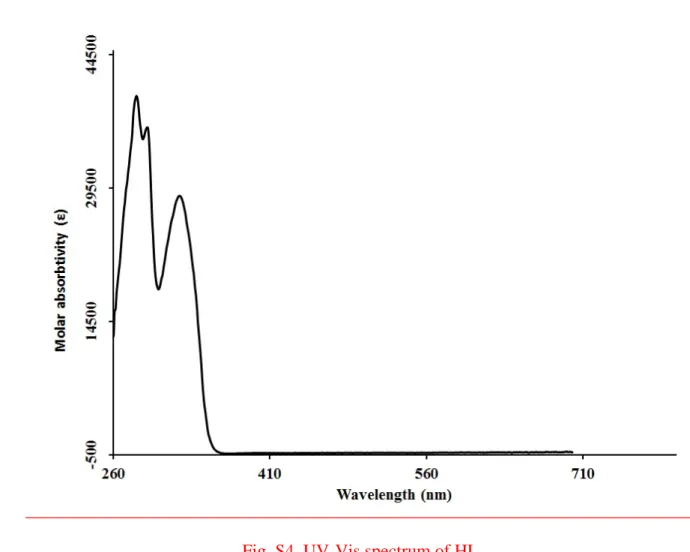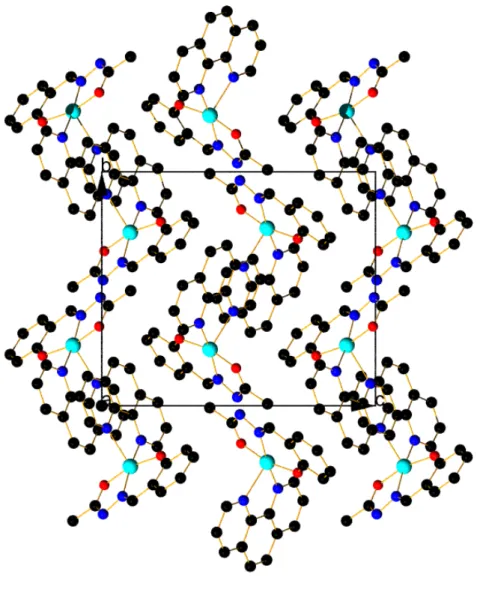A new mixed-ligand copper(II) complex of
(E)-N'-(2-hydroxybenzylidene) acetohydrazide: Synthesis, characterization,
NLO behavior, DFT calculation and biological activities
S. Yousef Ebrahimipour
1*
, Iran Sheikhshoaie, Aurelien Crochet, Moj Khaleghi, Katharina M.
Fromm
Fig. S1. Molecular orbital surfaces and energy levels of HL
∗1
Dr. S. Yousef Ebrahimipour
Department of Chemistry, Faculty of Science, Shahid Bahonar University of Kerman
76175-133, Kerman, Iran
Tel/fax: +98 (341) 3222033, e mail: ebrahimipour@uk.ac.ir, ebrahimipour@ymail.com
HOMO
HOMO-1
HOMO-2
LUMO
LUMO+1
LUMO+2
Table S1. Energy and frontier molecular orbital compositions of [CuL(phen)] (α spin)
MO Energy (eV) symmetry L (%) Cu (%) Phen (%)
L+10 1.14 A 89 10 1 L+9 1.1 A 0 94 6 L+8 1.07 A 0 0 100 L+7 0.96 A 5 93 2 L+6 0.84 A 7 92 1 L+5 0.52 A 4 85 11 L+4 -0.15 A 0 0 100 L+3 -0.7 A 96 1 3 L+2 -0.91 A 2 1 97 L+1 -2.13 A 0 0 100 LUMO -2.23 A 0 0 99 HOMO -4.63 A 96 3 1 H-1 -5.32 A 98 2 0 H-2 -5.36 A 76 19 5 H-3 -6.41 A 83 12 5 H-4 -6.61 A 97 3 0 H-5 -6.94 A 60 16 24 H-6 -7 A 11 3 86 H-7 -7.29 A 31 28 41 H-8 -7.37 A 0 0 100 H-9 -7.83 A 72 26 2 H-10 -8.33 A 59 22 19
Table S2. Energy and frontier molecular orbital compositions of [CuL(phen)] (β spin)
MO Energy (eV) Symmetry L (%) Cu(%) Phen (%)
L+10 1.11 A 0 92 8 L+9 1.07 A 0 0 100 L+8 0.97 A 5 93 2 L+7 0.85 A 7 93 0 L+6 0.52 A 4 85 11 L+5 -0.15 A 0 0 100 L+4 -0.66 A 96 2 2 L+3 -0.91 A 2 1 97 L+2 -1.66 A 34 61 5 L+1 -2.13 A 0 0 100 LUMO -2.22 A 0 1 99 HOMO -4.58 A 95 4 1 H-1 -5.28 A 97 3 0 H-2 -6.05 A 85 12 3 H-3 -6.52 A 74 19 7 H-4 -6.62 A 83 12 5 H-5 -6.96 A 14 12 74 H-6 -7.04 A 30 22 48 H-7 -7.36 A 0 2 98 H-8 -7.52 A 67 28 5 H-9 -7.63 A 61 37 2 H-10 -7.96 A 13 84 3
Table S3. Atomic coordinates ( x 104) and equivalent isotropic displacement parameters (Å2x 103) for
[CuL(phen)]. U(eq) is defined as one third of the trace of the orthogonalized Uij tensor.
________________________________________________________________________________ x y z U(eq) ________________________________________________________________________________ Cu(1) 7063(1) 2411(1) 3955(1) 38(1) N(3) 8164(2) 1132(2) 4241(2) 36(1) O(1) 7836(2) 2861(2) 2838(1) 47(1) N(2) 5651(2) 3528(2) 3563(1) 38(1) O(2) 6201(2) 1610(1) 4908(1) 45(1) C(13) 8923(2) 2536(2) 2644(2) 38(1) N(4) 7834(2) 373(2) 4952(2) 39(1) C(19) 9170(2) 945(2) 3881(2) 39(1) C(11) 5798(2) 4617(2) 3877(2) 37(1) N(1) 7667(2) 4045(2) 4817(2) 41(1) C(20) 6807(2) 729(2) 5240(2) 39(1) C(12) 6871(2) 4897(2) 4539(2) 38(1) C(17) 10760(2) 1333(2) 2841(2) 46(1) C(18) 9602(2) 1626(2) 3123(2) 38(1) C(14) 9471(2) 3110(2) 1905(2) 44(1) C(10) 4639(2) 3261(3) 2976(2) 49(1) C(2) 8890(3) 5408(3) 5802(2) 66(1) C(15) 10606(3) 2810(2) 1654(2) 48(1) C(7) 4914(3) 5466(2) 3592(2) 47(1) C(4) 7037(3) 6029(2) 4877(2) 49(1) C(3) 8092(3) 6255(3) 5520(2) 62(1) C(8) 3878(3) 5144(3) 2953(2) 56(1) C(1) 8649(3) 4303(3) 5439(2) 54(1) C(21) 6320(2) 83(2) 6055(2) 48(1) C(6) 5103(3) 6590(3) 3974(2) 59(1) C(16) 11261(2) 1912(2) 2123(2) 48(1) C(5) 6108(3) 6856(2) 4572(2) 62(1) C(9) 3750(3) 4053(3) 2644(2) 60(1) ________________________________________________________________________________
Table S4. Anisotropic displacement parameters (Å2x 103)for [CuL(phen)]. The anisotropic
displacement factor exponent takes the form: -2p2[ h2a*2U11 + ... + 2 h k a* b* U12 ]
______________________________________________________________________________ U11 U22 U33 U23 U13 U12 ______________________________________________________________________________ Cu(1) 36(1) 36(1) 43(1) 0(1) 7(1) 6(1) N(3) 35(1) 37(1) 37(1) -1(1) 6(1) 1(1) O(1) 43(1) 50(1) 50(1) 10(1) 11(1) 14(1) N(2) 35(1) 45(1) 34(1) -2(1) 6(1) 4(1) O(2) 40(1) 43(1) 54(1) 3(1) 13(1) 7(1) C(13) 37(1) 37(1) 40(1) -4(1) 5(1) 1(1) N(4) 41(1) 39(1) 38(1) 3(1) 7(1) 2(1) C(19) 40(1) 35(1) 42(1) 0(1) 2(1) 7(1) C(11) 39(1) 44(1) 30(1) 5(1) 12(1) 8(1) N(1) 39(1) 44(1) 38(1) 4(1) 0(1) -1(1) C(20) 36(1) 40(1) 42(1) -4(1) 4(1) -3(1) C(12) 44(1) 40(1) 32(1) 2(1) 15(1) 1(1) C(17) 42(1) 46(1) 52(2) 2(1) 9(1) 8(1) C(18) 35(1) 41(1) 39(1) -2(1) 6(1) 1(1) C(14) 47(2) 42(1) 42(2) 5(1) 6(1) 3(1) C(10) 40(1) 66(2) 41(2) -6(1) 5(1) -2(1) C(2) 60(2) 92(3) 44(2) -8(2) 3(2) -32(2) C(15) 50(2) 51(2) 45(2) 0(1) 11(1) -6(1) C(7) 54(2) 51(2) 39(1) 13(1) 24(1) 20(1) C(4) 66(2) 45(1) 39(2) -5(1) 23(1) -7(1) C(3) 79(2) 59(2) 51(2) -14(2) 24(2) -23(2) C(8) 40(2) 84(2) 47(2) 22(2) 10(1) 21(2) C(1) 45(2) 69(2) 48(2) 9(1) -1(1) -7(1) C(21) 41(1) 53(2) 50(2) 4(1) 10(1) -3(1) C(6) 76(2) 50(2) 56(2) 13(1) 32(2) 24(2) C(16) 39(1) 53(2) 55(2) 3(1) 15(1) 4(1) C(5) 95(3) 38(1) 61(2) -1(1) 43(2) 8(2) C(9) 39(2) 96(2) 45(2) 8(2) 3(1) 7(2) ______________________________________________________________________________
Table S5. Hydrogen coordinates ( x 104) and isotropic displacement parameters (Å2x 103) for [CuL(phen)]. ________________________________________________________________________________ x y z U(eq) ________________________________________________________________________________ H(19) 9652 332 4125 47 H(17) 11195 729 3153 55 H(14) 9050 3712 1577 52 H(10) 4524 2505 2779 59 H(2) 9592 5556 6232 79 H(15) 10938 3212 1166 58 H(3) 8246 6992 5755 74 H(8) 3280 5681 2743 68 H(1) 9202 3724 5644 65 H(21A) 6495 502 6653 71 H(21B) 6708 -652 6124 71 H(21C) 5447 -13 5907 71 H(6) 4512 7148 3802 71 H(16) 12027 1707 1951 58 H(5) 6209 7602 4798 74 H(9) 3072 3837 2213 72 ________________________________________________________________________________
![Fig. S2. Contour plots of some selected MOs ( α-spin) of [CuL(phen)].](https://thumb-eu.123doks.com/thumbv2/123doknet/15018660.682323/2.918.108.805.220.677/fig-contour-plots-selected-mos-spin-cul-phen.webp)
![Fig. S3. UV-Vis spectrum of [CuL(phen)] under the effect of irradiation 3 h in DMSO.](https://thumb-eu.123doks.com/thumbv2/123doknet/15018660.682323/3.918.198.723.174.593/fig-vis-spectrum-cul-phen-effect-irradiation-dmso.webp)




![Table S1. Energy and frontier molecular orbital compositions of [CuL(phen)] (α spin)](https://thumb-eu.123doks.com/thumbv2/123doknet/15018660.682323/8.918.208.713.218.739/table-energy-frontier-molecular-orbital-compositions-cul-phen.webp)
![Table S2. Energy and frontier molecular orbital compositions of [CuL(phen)] (β spin)](https://thumb-eu.123doks.com/thumbv2/123doknet/15018660.682323/9.918.196.723.215.729/table-energy-frontier-molecular-orbital-compositions-cul-phen.webp)
![Table S3. Atomic coordinates ( x 104) and equivalent isotropic displacement parameters (Å2x 103) for [CuL(phen)]](https://thumb-eu.123doks.com/thumbv2/123doknet/15018660.682323/10.918.153.759.223.1052/table-atomic-coordinates-equivalent-isotropic-displacement-parameters-cul.webp)
![Table S4. Anisotropic displacement parameters (Å2x 103)for [CuL(phen)]. The anisotropic displacement factor exponent takes the form: -2p2[ h2a*2U11 + ..](https://thumb-eu.123doks.com/thumbv2/123doknet/15018660.682323/11.918.160.749.221.1067/table-anisotropic-displacement-parameters-anisotropic-displacement-factor-exponent.webp)